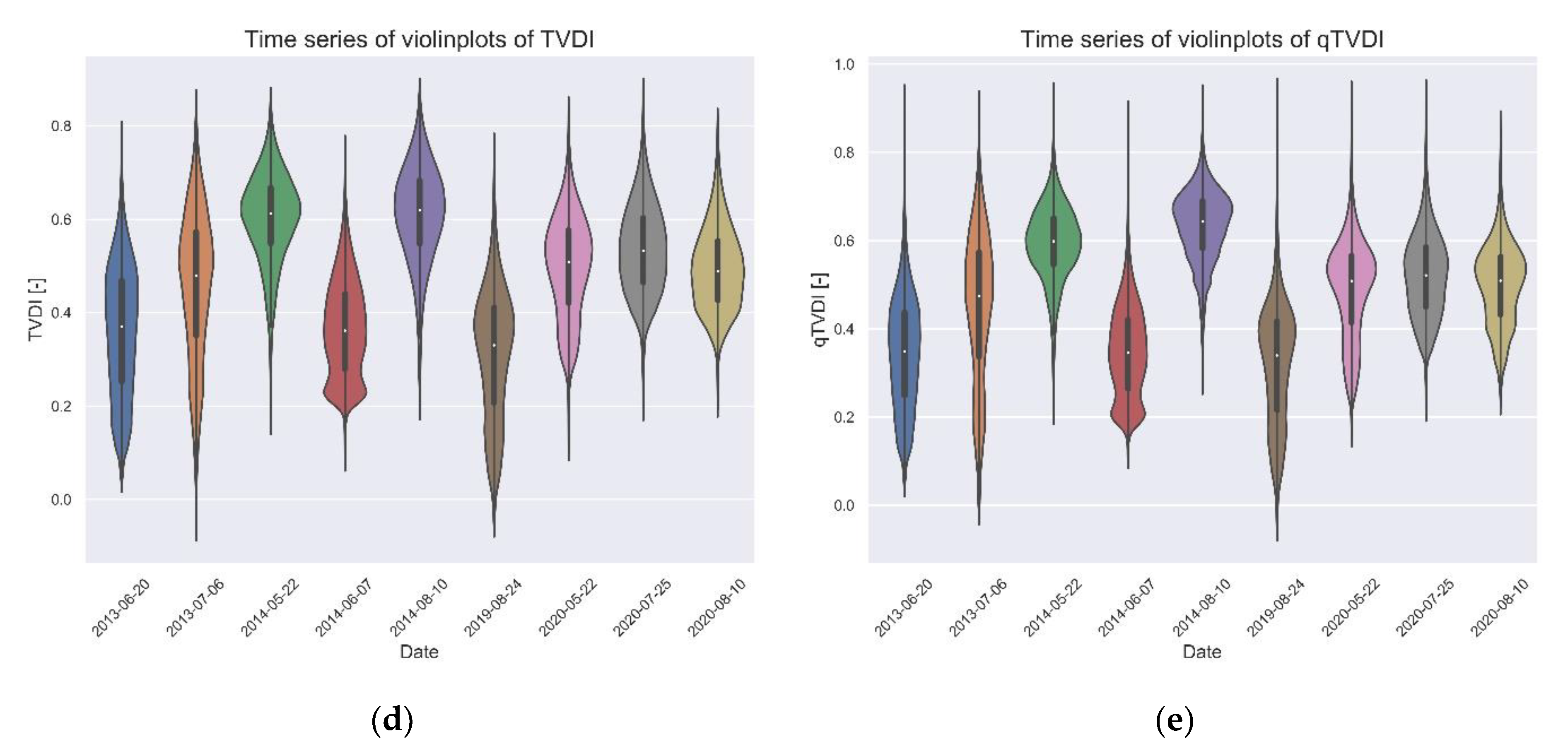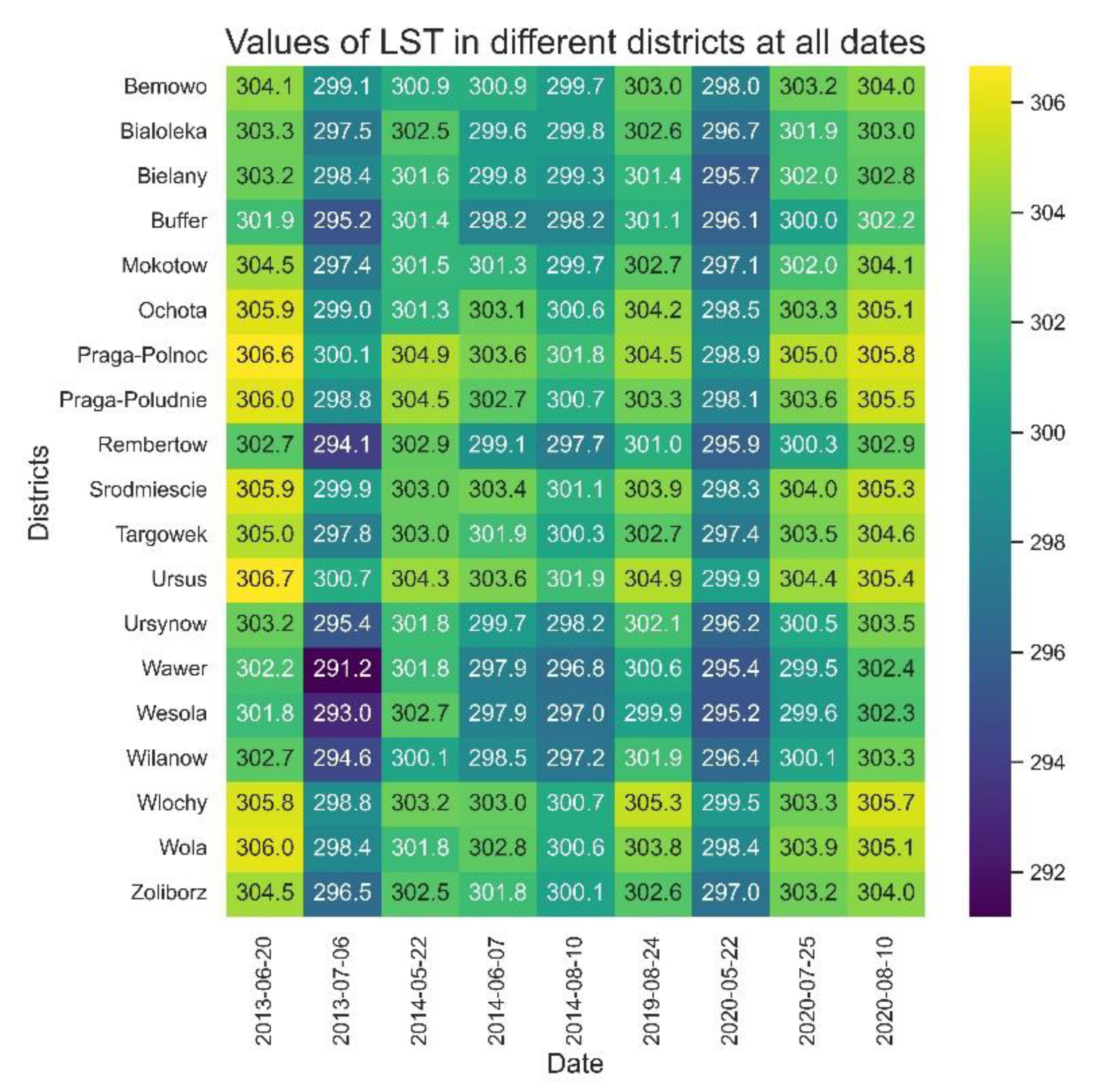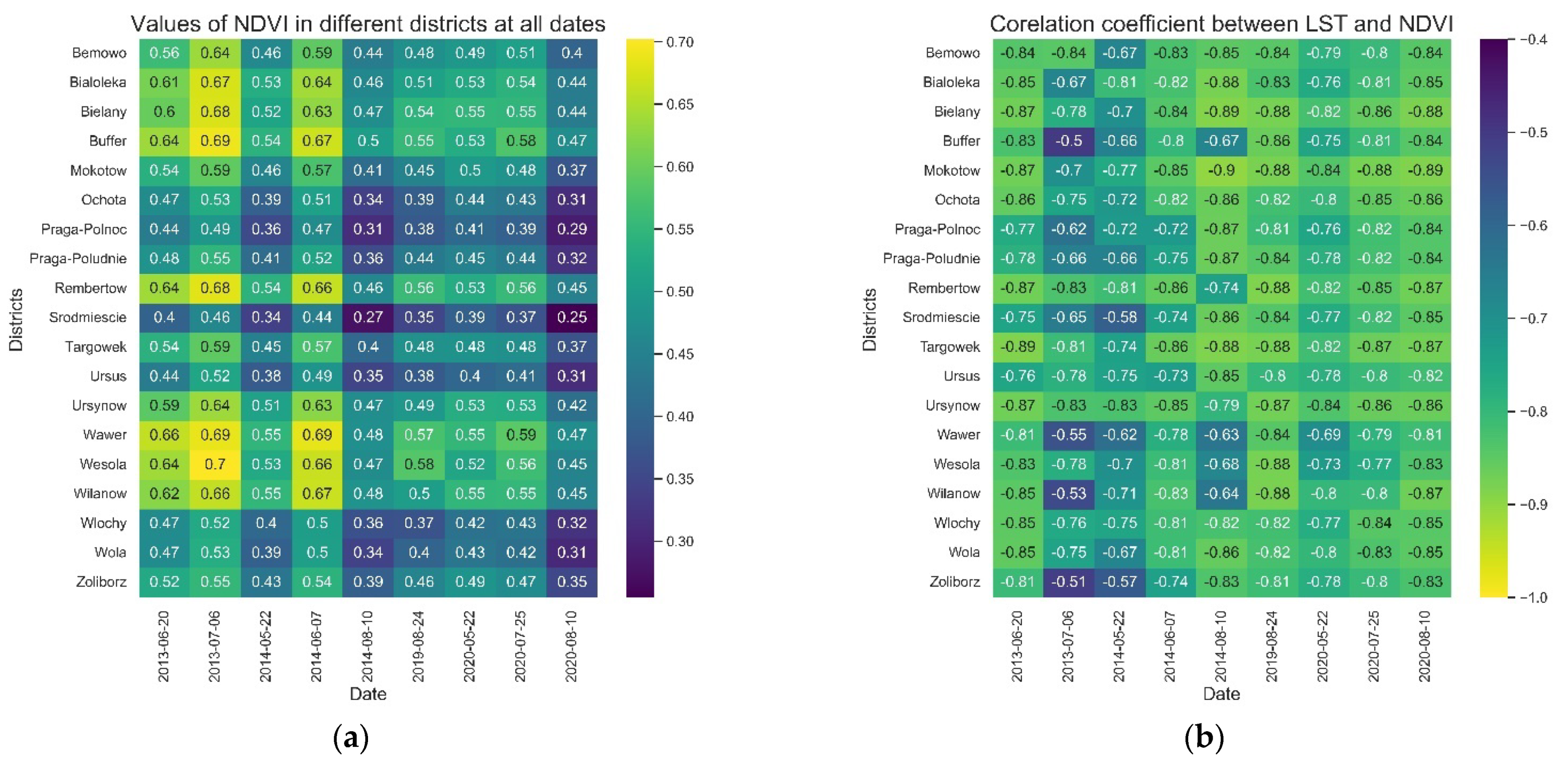Impact of the Variability of Vegetation, Soil Moisture, and Building Density between City Districts on Land Surface Temperature, Warsaw, Poland
Abstract
1. Introduction
2. Materials
2.1. Study Area
2.2. Landsat 8 OLI/TIRS Images
3. Methods
3.1. Image Preprocessing
3.2. Computation of Land Surface Temperature
3.3. Computation of Satellite Pixel-By-Pixel Indexes
3.3.1. Vegetation Indexes
3.3.2. Normalized Difference Built-Up Index
3.4. Estimation of Moisture Condition Using LST-VI Scatterplot
4. Results
4.1. Comparison of the Results for Different Districts
4.2. Temporal Changes of the Statistical Distribution of Studied Parameters in the Whole Warsaw Area for the Years 2013–2020
4.3. Correlation of Estimated Parameters for the Whole Research Area
4.4. Crosswise Distribution of the Studied Parameters and the Dependence of LST on Them in Terms of Districts and Dates
5. Conclusions
Supplementary Materials
Author Contributions
Funding
Institutional Review Board Statement
Informed Consent Statement
Data Availability Statement
Conflicts of Interest
References
- United Nations. World Population Prospects, the 2019 Revision-Volume I: Comprehensive Tables; United Nations: New York, NY, USA, 2019; ISBN 978-92-1-004642-8.
- Mensah, C.A. Destruction of Urban Green Spaces: A Problem Beyond Urbanization in Kumasi City (Ghana). Am. J. Environ. Prot. 2014, 3, 1. [Google Scholar] [CrossRef]
- Moreno, R.; Ojeda, N.; Azócar, J.; Venegas, C.; Inostroza, L. Application of NDVI for Identify Potentiality of the Urban Forest for the Design of a Green Corridors System in Intermediary Cities of Latin America: Case Study, Temuco, Chile. Urban For. Urban Green. 2020, 55, 126821. [Google Scholar] [CrossRef]
- Gawuc, L.; Jefimow, M.; Szymankiewicz, K.; Kuchcik, M.; Sattari, A.; Struzewska, J. Statistical Modeling of Urban Heat Island Intensity in Warsaw, Poland Using Simultaneous Air and Surface Temperature Observations. IEEE J. Sel. Top. Appl. Earth Obs. Remote Sens. 2020, 13, 2716–2728. [Google Scholar] [CrossRef]
- Mora, C.; Dousset, B.; Caldwell, I.R.; Powell, F.E.; Geronimo, R.C.; Bielecki, C.R.; Counsell, C.W.W.; Dietrich, B.S.; Johnston, E.T.; Louis, L.V.; et al. Global Risk of Deadly Heat. Nat. Clim. Chang. 2017, 7, 501–506. [Google Scholar] [CrossRef]
- Venter, Z.S.; Brousse, O.; Esau, I.; Meier, F. Hyperlocal Mapping of Urban Air Temperature Using Remote Sensing and Crowdsourced Weather Data. Remote Sens. Environ. 2020, 242, 111791. [Google Scholar] [CrossRef]
- Bizjak, M.; Žalik, B.; Štumberger, G.; Lukač, N. Estimation and Optimisation of Buildings’ Thermal Load Using LiDAR Data. Build. Environ. 2018, 128, 12–21. [Google Scholar] [CrossRef]
- Van, T.T.; Tran, N.D.H.; Bao, H.D.X.; Phuong, D.T.T.; Hoa, P.K.; Han, T.T.N. Optical Remote Sensing Method for Detecting Urban Green Space as Indicator Serving City Sustainable Development. Proceedings 2017, 2, 140. [Google Scholar] [CrossRef]
- Haq, S.M.A. Urban Green Spaces and an Integrative Approach to Sustainable Environment. J. Environ. Prot. 2011, 02, 601–608. [Google Scholar] [CrossRef]
- Liu, Y.; Meng, Q.; Zhang, J.; Zhang, L.; Jancso, T.; Vatseva, R. An Effective Building Neighborhood Green Index Model for Measuring Urban Green Space. Int. J. Digit. Earth 2016, 9, 387–409. [Google Scholar] [CrossRef]
- Hari, V.; Rakovec, O.; Markonis, Y.; Hanel, M.; Kumar, R. Increased Future Occurrences of the Exceptional 2018–2019 Central European Drought under Global Warming. Sci. Rep. 2020, 10, 12207. [Google Scholar] [CrossRef]
- Zhang, R.; Zhao, C.; Ma, X.; Brindha, K.; Han, Q.; Li, C.; Zhao, X. Projected Spatiotemporal Dynamics of Drought under Global Warming in Central Asia. Sustainability 2019, 11, 4421. [Google Scholar] [CrossRef]
- Vicente-Serrano, S.M.; Quiring, S.M.; Peña-Gallardo, M.; Yuan, S.; Domínguez-Castro, F. A Review of Environmental Droughts: Increased Risk under Global Warming? Earth-Sci. Rev. 2020, 201, 102953. [Google Scholar] [CrossRef]
- Kong, D.; Gu, X.; Li, J.; Ren, G.; Liu, J. Contributions of Global Warming and Urbanization to the Intensification of Human-Perceived Heatwaves Over China. J. Geophys. Res. Atmospheres 2020, 125, e2019JD032175. [Google Scholar] [CrossRef]
- Lemonsu, A.; Viguié, V.; Daniel, M.; Masson, V. Vulnerability to Heat Waves: Impact of Urban Expansion Scenarios on Urban Heat Island and Heat Stress in Paris (France). Urban Clim. 2015, 14, 586–605. [Google Scholar] [CrossRef]
- Mariani, L.; Parisi, S.G.; Cola, G.; Lafortezza, R.; Colangelo, G.; Sanesi, G. Climatological Analysis of the Mitigating Effect of Vegetation on the Urban Heat Island of Milan, Italy. Sci. Total Environ. 2016, 569–570, 762–773. [Google Scholar] [CrossRef]
- Qiu, G.; Li, H.; Zhang, Q.; Chen, W.; Liang, X.; Li, X. Effects of Evapotranspiration on Mitigation of Urban Temperature by Vegetation and Urban Agriculture. J. Integr. Agric. 2013, 12, 1307–1315. [Google Scholar] [CrossRef]
- Chun, B.; Guldmann, J.-M. Impact of Greening on the Urban Heat Island: Seasonal Variations and Mitigation Strategies. Comput. Environ. Urban Syst. 2018, 71, 165–176. [Google Scholar] [CrossRef]
- Sandholt, I.; Rasmussen, K.; Andersen, J. A Simple Interpretation of the Surface Temperature/Vegetation Index Space for Assessment of Surface Moisture Status. Remote Sens. Environ. 2002, 79, 213–224. [Google Scholar] [CrossRef]
- Gillies, R.R.; Kustas, W.P.; Humes, K.S. A Verification of the “triangle” Method for Obtaining Surface Soil Water Content and Energy Fluxes from Remote Measurements of the Normalized Difference Vegetation Index (NDVI) and Surface e. Int. J. Remote Sens. 1997, 18, 3145–3166. [Google Scholar] [CrossRef]
- Wang, C.; Qi, S.; Niu, Z.; Wang, J. Evaluating Soil Moisture Status in China Using the Temperature–Vegetation Dryness Index (TVDI). Can. J. Remote Sens. 2004, 30, 671–679. [Google Scholar] [CrossRef]
- Carlson, T. An Overview of the “Triangle Method” for Estimating Surface Evapotranspiration and Soil Moisture from Satellite Imagery. Sensors 2007, 7, 1612–1629. [Google Scholar] [CrossRef]
- Petropoulos, G.P.; Ireland, G.; Barrett, B. Surface Soil Moisture Retrievals from Remote Sensing: Current Status, Products & Future Trends. Phys. Chem. Earth Parts ABC 2015, 83–84, 36–56. [Google Scholar] [CrossRef]
- Przeździecki, K.; Zawadzki, J.J. Triangle Method Modification with Second Degree Polynomial Edges Fitting in LST NDVI Scatterplot in Lignite Mine Influence Area. Remote Sens. Appl. Soc. Environ. 2020, 20, 100404. [Google Scholar] [CrossRef]
- Köppen Climate Classification (Weatherbase). Available online: http://www.weatherbase.com/weather/weather-summary.php3?s=57321&cityname=Warsaw,+Poland (accessed on 25 February 2022).
- Lindner-Cendrowska, K.; Błażejczyk, K. Impact of Selected Personal Factors on Seasonal Variability of Recreationist Weather Perceptions and Preferences in Warsaw (Poland). Int. J. Biometeorol. 2018, 62, 113–125. [Google Scholar] [CrossRef] [PubMed]
- Urząd Statystyczny w Warszawie/Dane o Województwie/Stolica Województwa/Ludność. Available online: https://warszawa.stat.gov.pl/dane-o-wojewodztwie/stolica-wojewodztwa/ludnosc/ (accessed on 25 February 2022).
- EROS Landsat 8 (L8) Data Users Handbook; U.S. Geological Survey: Sioux Falls, SD, USA, 2019; p. 114.
- Landsat Levels of Processing. Available online: https://www.usgs.gov/land-resources/nli/landsat/landsat-levels-processing (accessed on 8 April 2020).
- EarthExplorer. Available online: https://earthexplorer.usgs.gov/ (accessed on 19 March 2022).
- Chavez, P. Image-Based Atmospheric Corrections-Revisited and Improved. Photogramm. Eng. Remote Sens. 1996, 62, 1025–1035. [Google Scholar]
- Xu, H. Modification of Normalised Difference Water Index (NDWI) to Enhance Open Water Features in Remotely Sensed Imagery. Int. J. Remote Sens. 2006, 27, 3025–3033. [Google Scholar] [CrossRef]
- Bhatti, S.S.; Tripathi, N.K. Built-up Area Extraction Using Landsat 8 OLI Imagery. GIScience Remote Sens. 2014, 51, 445–467. [Google Scholar] [CrossRef]
- Zawadzki, J.; Przeździecki, K.; Miatkowski, Z. Determining the Area of Influence of Depression Cone in the Vicinity of Lignite Mine by Means of Triangle Method and LANDSAT TM/ETM+ Satellite Images. J. Environ. Manage. 2016, 166, 605–614. [Google Scholar] [CrossRef]
- Zha, Y.; Gao, J.; Ni, S. Use of Normalized Difference Built-up Index in Automatically Mapping Urban Areas from TM Imagery. Int. J. Remote Sens. 2003, 24, 583–594. [Google Scholar] [CrossRef]
- Wetherley, E.B.; McFadden, J.P.; Roberts, D.A. Megacity-Scale Analysis of Urban Vegetation Temperatures. Remote Sens. Environ. 2018, 213, 18–33. [Google Scholar] [CrossRef]







| Id | District | Area (km2) | Population (in Thousands) (2019) | Includes Vistula River |
|---|---|---|---|---|
| 0 | Buffer | 610.3 | - | 1 |
| 1 | Praga-Południe | 22.4 | 180.8 | 1 |
| 2 | Mokotów | 35.4 | 218.3 | 1 |
| 3 | Żoliborz | 8.5 | 52.8 | 1 |
| 4 | Wesoła | 22.9 | 25.8 | 0 |
| 5 | Wawer | 79.7 | 78.2 | 1 |
| 6 | Wola | 19.3 | 141.4 | 0 |
| 7 | Wilanów | 36.7 | 42.1 | 1 |
| 8 | Śródmieście | 15.6 | 113.7 | 1 |
| 9 | Praga-Północ | 11.3 | 63.5 | 1 |
| 10 | Włochy | 28.6 | 43.6 | 0 |
| 11 | Ursynów | 43.8 | 151.3 | 0 |
| 12 | Rembertów | 19.3 | 24.5 | 0 |
| 13 | Ochota | 9.7 | 82.5 | 0 |
| 14 | Ursus | 9.4 | 61.3 | 0 |
| 15 | Targówek | 24.3 | 125 | 1 |
| 16 | Bemowo | 24.9 | 125.1 | 0 |
| 17 | Bielany | 32.3 | 131.6 | 1 |
| 18 | Białołęka | 73.0 | 129.1 | 1 |
| - | Warsaw area | 517.2 | 1790.7 | - |
| - | Whole research area | 1127.5 | - | - |
| No. | File Name | Date |
|---|---|---|
| 1 | LC08_L1TP_188024_20130620_20170503_01_T1 | 20 June 2013 |
| 2 | LC08_L1TP_188024_20130706_20170503_01_T1 | 6 July 2013 |
| 3 | LC08_L1TP_188024_20140522_20180527_01_T1 | 22 May 2014 |
| 4 | LC08_L1TP_188024_20140607_20170422_01_T1 | 7 June 2014 |
| 5 | LC08_L1TP_188024_20140810_20170420_01_T1 | 10 August 2014 |
| 6 | LC08_L1TP_188024_20190824_20190903_01_T1 | 24 August 2019 |
| 7 | LC08_L1TP_188024_20200522_20200820_02_T1 | 22 May 2020 |
| 8 | LC08_L1TP_188024_20200725_20200908_02_T1 | 25 July 2020 |
| 9 | LC08_L1TP_188024_20200810_20200918_02_T1 | 10 August 2020 |
| District | LST | NDBI | NDVI | TVDI | qTVDI | Percent of Water Pixels |
|---|---|---|---|---|---|---|
| Bemowo | 301.44 | −0.20 | 0.51 | 0.52 | 0.52 | 0.04 |
| Bialoleka | 300.74 | −0.22 | 0.55 | 0.52 | 0.51 | 2.51 |
| Bielany | 300.45 | −0.25 | 0.55 | 0.50 | 0.49 | 3.30 |
| Buffer | 299.36 | −0.24 | 0.58 | 0.46 | 0.45 | 1.31 |
| Mokotow | 301.16 | −0.21 | 0.49 | 0.49 | 0.50 | 1.85 |
| Ochota | 302.34 | −0.17 | 0.42 | 0.51 | 0.53 | 0.31 |
| Praga-Polnoc | 303.47 | −0.15 | 0.39 | 0.54 | 0.57 | 7.59 |
| Praga-Poludnie | 302.58 | −0.18 | 0.44 | 0.53 | 0.54 | 2.43 |
| Rembertow | 299.61 | −0.25 | 0.56 | 0.46 | 0.45 | 0.45 |
| Srodmiescie | 302.76 | −0.14 | 0.36 | 0.49 | 0.53 | 4.63 |
| Targowek | 301.80 | −0.20 | 0.48 | 0.52 | 0.53 | 0.07 |
| Ursus | 303.52 | −0.15 | 0.41 | 0.56 | 0.57 | 0.06 |
| Ursynow | 300.07 | −0.23 | 0.53 | 0.47 | 0.46 | 0.22 |
| Wawer | 298.64 | −0.27 | 0.58 | 0.42 | 0.41 | 2.37 |
| Wesola | 298.82 | −0.25 | 0.57 | 0.42 | 0.41 | 1.71 |
| Wilanow | 299.44 | −0.23 | 0.56 | 0.46 | 0.45 | 2.85 |
| Wlochy | 302.80 | −0.15 | 0.42 | 0.54 | 0.56 | 0.15 |
| Wola | 302.31 | −0.17 | 0.42 | 0.51 | 0.53 | 0.12 |
| Zoliborz | 301.36 | −0.20 | 0.47 | 0.49 | 0.49 | 5.17 |
| LST | NDBI | NDVI | TVDI | qTVDI | |
|---|---|---|---|---|---|
| LST | 1.00 | 0.83 | −0.86 | 0.34 | 0.78 |
| NDBI | 1.00 | −0.88 | −0.02 | 0.45 | |
| NDVI | 1.00 | 0.19 | −0.37 | ||
| TVDI | 1.00 | 0.83 | |||
| qTVDI | 1.00 |
Disclaimer/Publisher’s Note: The statements, opinions and data contained in all publications are solely those of the individual author(s) and contributor(s) and not of MDPI and/or the editor(s). MDPI and/or the editor(s) disclaim responsibility for any injury to people or property resulting from any ideas, methods, instructions or products referred to in the content. |
© 2023 by the authors. Licensee MDPI, Basel, Switzerland. This article is an open access article distributed under the terms and conditions of the Creative Commons Attribution (CC BY) license (https://creativecommons.org/licenses/by/4.0/).
Share and Cite
Przeździecki, K.; Zawadzki, J. Impact of the Variability of Vegetation, Soil Moisture, and Building Density between City Districts on Land Surface Temperature, Warsaw, Poland. Sustainability 2023, 15, 1274. https://doi.org/10.3390/su15021274
Przeździecki K, Zawadzki J. Impact of the Variability of Vegetation, Soil Moisture, and Building Density between City Districts on Land Surface Temperature, Warsaw, Poland. Sustainability. 2023; 15(2):1274. https://doi.org/10.3390/su15021274
Chicago/Turabian StylePrzeździecki, Karol, and Jarosław Zawadzki. 2023. "Impact of the Variability of Vegetation, Soil Moisture, and Building Density between City Districts on Land Surface Temperature, Warsaw, Poland" Sustainability 15, no. 2: 1274. https://doi.org/10.3390/su15021274
APA StylePrzeździecki, K., & Zawadzki, J. (2023). Impact of the Variability of Vegetation, Soil Moisture, and Building Density between City Districts on Land Surface Temperature, Warsaw, Poland. Sustainability, 15(2), 1274. https://doi.org/10.3390/su15021274







